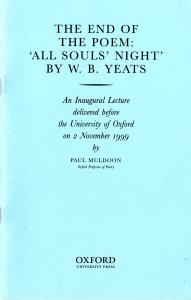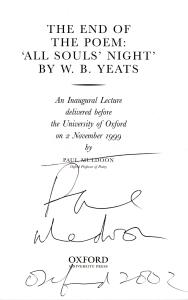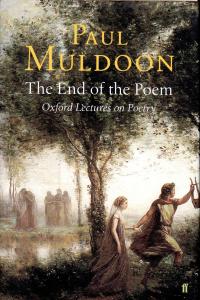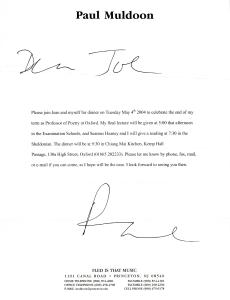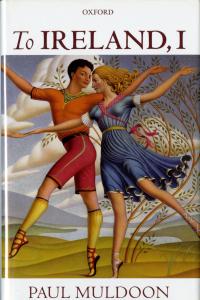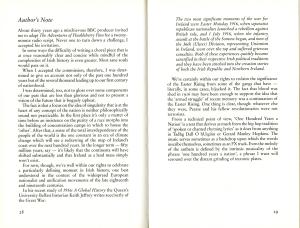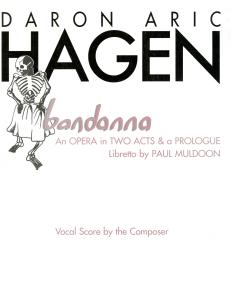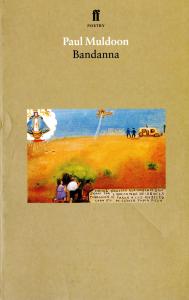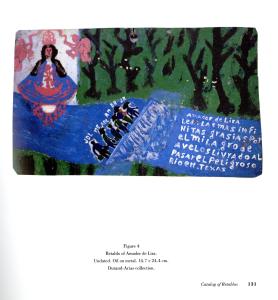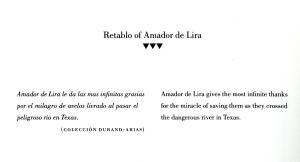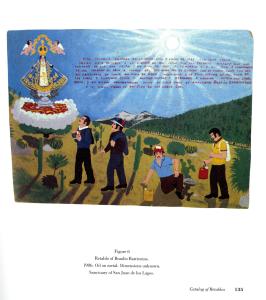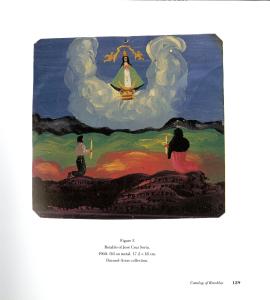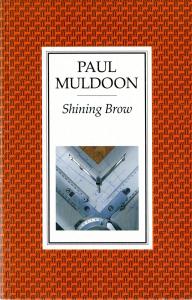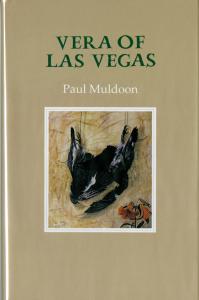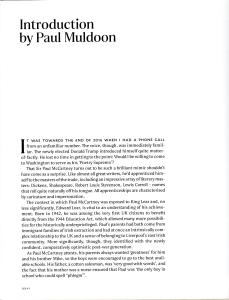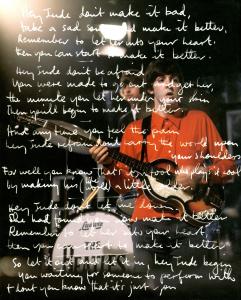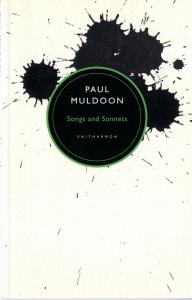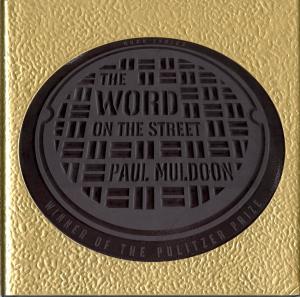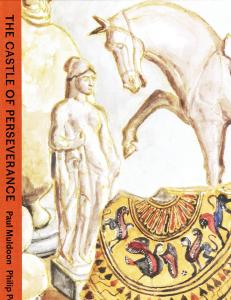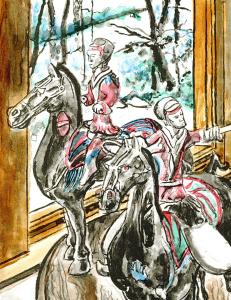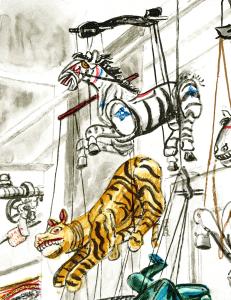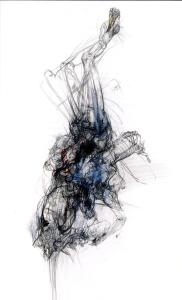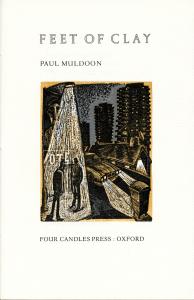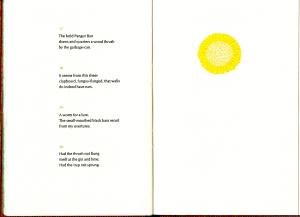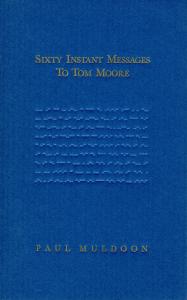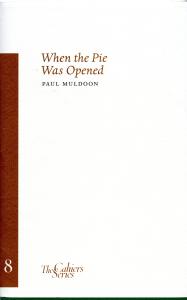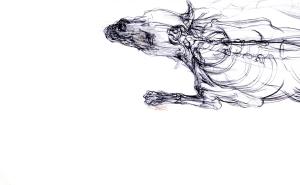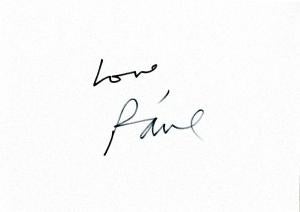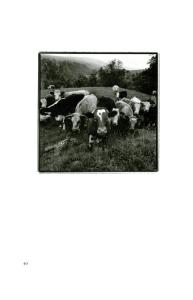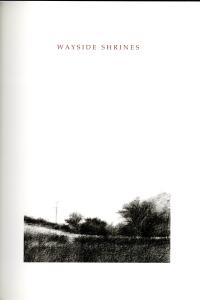Paul Muldoon: The Joseph M. Hassett Collection explores the work of Irish poet Paul Muldoon through a collection of published work donated to Lauinger Library by Joseph M. Hassett. Housed in the Booth Family Center for Special Collections Gallery at Lauinger Library, the exhibition takes visitors on a journey through Muldoon’s life and work, as well as his friendship with Hassett, as reflected in inscriptions, correspondence, and photographs.
Hassett’s extensive collection features some of Muldoon’s rarest limited-edition publications. These mesmerizing objects offer an unusually rich glimpse into Muldoon’s collaborations with printmakers, painters, illustrators, photographers, and musicians. Drawing on manuscripts, drafts, letters, and revisions, the exhibition seeks to tap into Muldoon’s creative process, examining the political pressures that shaped his early work in Troubles-era Belfast, his migration to the United States in 1987, and the editorial relationships and artistic community that surround him.
Paul Muldoon: The Joseph M. Hassett Collection is curated by Chris Kenny (MA English, ’23) and hosted by the Booth Family Center for Special Collections at Lauinger Library with the assistance of Georgetown Global Irish Studies, Dr. Cóilín Parsons (Associate Professor of English and Director of Global Irish Studies), Jay Sylvestre (Rare Books Curator), LuLen Walker (Art Curator), and Keith Gorman (Director, Booth Family Center for Special Collections).
Beginnings
Described by The Times Literary Supplement as “the most significant English-language poet born since the second World War,” Paul Muldoon has authored more than 30 collections of poetry, drama, lyrics, translations, and criticism. Muldoon’s numerous prizes include a Guggenheim Fellowship (1990), the Sir Geoffrey Faber Memorial Prize (1992), the T.S. Eliot Prize (1994), the Irish Times’ Irish Literature Prize (1997), the Pulitzer Prize (2003), and the Queen’s Gold Medal for Poetry (2017).
Muldoon was Professor of Poetry at Oxford University from 1999 to 2004, poetry editor of The New Yorker from 2007 to 2017, and, since 1987, has held a professorship at Princeton University, where he currently occupies the Howard GB Clark ’21 chair in the Humanities. In November of 2022, Irish President Michael Higgins named Muldoon the Ireland Professor of Poetry.
Born in 1951 to a farmer and a schoolteacher, Muldoon was raised in a Catholic nationalist enclave, near a village called The Moy on the border of counties Armagh and Tyrone. He attended Queen’s University Belfast, where he participated in the Belfast Group, a weekly poetry workshop of Northern Irish poets, many of whom, including his mentor and future Nobel laureate (1995) Seamus Heaney, would go on to achieve prominence.
In 1971, at the onset of the Troubles, the nineteen-year-old Muldoon published Knowing My Place. In the mid-1980s, after publishing five full-length collections with Faber & Faber, Muldoon left his position as a BBC radio producer in Belfast to write full time. At this time he migrated to the United States.
Equal parts conversational and cryptic, Muldoon’s poems, in his own words, “engage in leading people on, gently, into little situations by assuring them that all’s well and then [...] leaving them high and dry, in some corner at a terrible party, where I’ve nipped out through the bathroom window.”
Head back to the west
Dermot Seymour (b. 1956)
1992
Oil on canvas
Fish, Flesh, and Fowl (Belfast & Dublin: Kevin Kavanagh Gallery & Golden Thread Gallery 2012
Lauinger Library
Out of the Blue
Paul Muldoon, James Simmons
Belfast: Arts Council of Northern Ireland, 1974
Joseph M. Hassett Collection, Booth Family Center for Special Collections
PR6063.U367 O9 1974
This short biography of Muldoon from his 1974 collaboration with James Simmons provides a snapshot of his early reception. Out of the Blue was the result of Simmons and Muldoon’s joint tour of eight venues in Northern Ireland between 25 November and 6 December 1974. The tour included an appearance at Muldoon’s home village of the Moy. Simmons, editor of The Honest Ulsterman, published Muldoon’s first poems in the May 1969 issue of the magazine, as well as his student chapbook, Knowing My Place (1971).
“The Sightseers,” Quoof
Paul Muldoon
London: Faber & Faber, 1983
Joseph M. Hassett Collection, Booth Family Center for Special Collections
PR6063.U367 Q6 1983b
In this poem a childhood family trip spurs meditations on the Troubles.
“Wind and Tree,” New Weather
Paul Muldoon
London: Faber & Faber, 1973
Joseph M. Hassett Collection, Booth Family Center for Special Collections
PR6063.U367 N4 1994
Muldoon’s first collection was published by Faber in the wake of Bloody Sunday in 1973. Eager to emphasize Muldoon’s connection to his mentor Seamus Heaney, his editors suggested the title New Weather, a nod to Heaney’s Wintering Out, published earlier that year. This rare first edition was mistakenly printed in italics, an error which was later corrected in a 1994 reprint.
“Wind and Tree,” New Weather
Paul Muldoon
London: Faber & Faber, 1994
Joseph M. Hassett Collection, Booth Family Center for Special Collections
PR6063.U367 N4 1994
Faber’s 1994 reprint saw a correction to the typographical error of the first edition. Faber also devised a new cover for the reprint, featuring their iconic (ff) pattern. The cover art, a Thomas Bewick wood engraving from A General History of Quadrupeds (1790), references Muldoon’s oft collected poem “Hedgehog.”
The Ulster Renaissance
In July 1962, the English critic and poet Philip Hobsbaum took a position as a lecturer in English at Queen’s University Belfast. There he started an informal poetry workshop now referred to as the Belfast Group. The Group’s earliest participants included Seamus Heaney, Michael Longley, and James Simmons, each of whom rose from obscurity to international prominence by the time of the Group’s dissolution a decade later.
Muldoon attended workshops while he was a student at Queen’s University Belfast, where he studied with Heaney. Simmons, editor of The Honest Ulsterman, published Muldoon’s first poems in the May 1969 issue of the magazine, as well as his student chapbook, Knowing My Place (1971). During these years, the internecine conflict in Northern Ireland known as the Troubles raised questions about the moral responsibility of poets, and the capacity of language to effect change.
Knowing My Place
Paul Muldoon
Belfast: Ulsterman Publications, 1971
Joseph M. Hassett Collection, Booth Family Center for Special Collections
PR6063.U367 K56 1971 Vault
Muldoon’s first chapbook was published while he was a student at Queen’s University Belfast at the onset of the Troubles. There he was a member of the Belfast Group, a weekly poetry workshop for Northern Irish poets begun by Philip Hobsbaum and continued by future Nobel laureate (1995) Seamus Heaney, along with Michael Allen and Arthur Terry.
The Honest Ulsterman No. 13
Various Authors
Belfast: Ulsterman Publications, May 1969
Lauinger Library
Now considered the most influential literary magazine in Belfast during the late sixties and early seventies, this independent publication, founded by James Simmons in 1968, quickly became a critical forum for Ulster Renaissance poets. This issue contains Muldoon’s first poem’s with the magazine.
Spirit of Dawn
Paul Muldoon
Belfast: Ulsterman Publications, 1975
Joseph M. Hassett Collection, Booth Family Center for Special Collections
PR6063.U367 S68 1975
Like Knowing My Place (1971), this rare first edition octavo was printed by Ulsterman Publications, an arm of The Honest Ulsterman literary magazine, edited by Belfast Group original James Simmons. All twelve of the poems included would be republished two years later in Muldoon’s second collection of verse with Faber & Faber, Mules (1977). Cover photo by John Middleton.
Names and Addresses
Paul Muldoon
Belfast: Ulsterman Publications, 1978
Joseph M. Hassett Collection, Booth Family Center for Special Collections
PR6063.U367 N36 1978
Muldoon’s final volume with Ulsterman Publications, the rare first edition octavo includes poems that would be republished two years later in Muldoon’s third collection with Faber & Faber, Why Brownlee Left (1980), which won the Geoffrey Faber Memorial Prize and confirmed Muldoon’s growing reputation.
Mules
Paul Muldoon
London: Faber & Faber, 1977
Joseph M. Hassett Collection, Booth Family Center for Special Collections
PR 6063.U367 M8 1977
Muldoon’s third collection was originally published with a two-tone brown cover including only text. Faber reprinted Mules in 1989 with their iconic (ff) pattern and cover art of a Thomas Bewick wood engraving from A General History of Quadrupeds (1790), a reference to the collection’s title poem. Faber’s 1994 reprint of New Weather is an echo of this design template.
A General History of Quadrupeds
Thomas Bewick
Newcastle upon Tyne: Printed by and for S. Hodgson, R. Beilby, and T. Bewick, 1790
Gift of John S. and Edith S. Mayfield, Booth Family Center for Special Collections
86A684
This comprehensive, late eighteenth-century illustrated nature guide showcases British engraver Thomas Bewick’s (1753-1828) groundbreaking techniques that allowed text and image to be published on the same page. The volume includes engravings of over four hundred animals, printed alongside scientific descriptions, current to the era. Bewick’s work reflects the zeal of eighteenth British colonists and travelers for observing and cataloguing the natural world.
The Troubles
The conflict in Northern Ireland known as the Troubles spanned three decades, from the late 1960s to the mid 1990s. Beginning with a campaign for civil rights for Catholic nationalists, the Troubles soon devolved into a low-level war between forces committed to some form of secession of Northern Ireland from the United Kingdom (nationalists) and forces committed to continued British rule (unionists, and the British government and its security forces). The violence of the Troubles led to over 3,500 deaths.
The first acknowledged casualty of the Troubles was John Scullion, who was shot by the unionist Ulster Volunteer Force at the door of his home at Oranmore Street in the Clonard area of west Belfast on 27 May 1966.
Among the most shocking incidents of the thirty-year period of violence was the Bloody Sunday massacre during a civil rights protest march in Derry/Londonderry on 30 January 1972. British Army paratroopers opened fire on the march, resulting in the deaths of 14 unarmed civilians. The events of Bloody Sunday fueled Catholic nationalist hostility towards the British Army, worsening the conflict.
On 8 November 1987, a Provisional Irish Republican Army bomb exploded near the War Memorial in Enniskillen, Co. Fermanagh during a Remembrance Sunday ceremony to commemorate British military war dead. 12 people were killed in the bombing. The attack was condemned by nationalists and unionists alike and marked a turning point in the Troubles.
On 6 April 1994 the IRA declared a ceasefire, beginning the process of ending the conflict. On 10 April 1998 the Belfast /Good Friday Agreement was signed, marking a major development in the Northern Irish peace process, establishing a devolved, power-sharing government, and largely bringing to an end three decades of political violence. While the Troubles have ended, the legacies of violence and of almost a century of division remain a part of the political, social, and artistic landscape of Northern Ireland.
Untitled
Gilles Peress (b. 1946)
1972
Photograph
Gilles Peress & Chris Klatell, Annals of the North / Whatever You Say, Say Nothing (Göttingen: Steidl, 2021)
Gelman Library Special Collections Research Center, George Washington University
The incongruities of daily life in Northern Ireland during British occupation. From French photographer Gilles Peress’ sprawling, 2000-page document of Northern Irish life in the 1970s and 80s, Annals of the North / Whatever You Say, Say Nothing. Peress is Professor of Human Rights and Photography at Bard College in New York and Senior Research Fellow at the Human Rights Center at UC Berkeley.
Loyalist News from Annals of the North
1971
News clipping
Gilles Peress & Chris Klatell, Annals of the North / Whatever You Say, Say Nothing (Göttingen: Steidl, 2021)
Gelman Library Special Collections Research Center, George Washington University
“Armageddon, Armageddon,” Mules
Paul Muldoon
London: Faber & Faber, 1977
Joseph M. Hassett Collection, Booth Family Center for Special Collections
PR 6063.U367 M8 1977
This haunting fragment told from the perspective of a child displaced by the Troubles closes the chilling sonnet sequence “Armageddon, Armageddon,” concluding Muldoon’s 1977 collection Mules.
Cloth: A Visual and Verbal Collaboration
Paul Muldoon, Rita Duffy (b. 1959, Belfast)
Portadown: Millennium Court Arts Centre, 2007
Joseph M. Hassett Collection, Booth Family Center for Special Collections
ND497.D85 A4 2007
This book was published on the occasion of Muldoon and Rita Duffy’s collaborative exhibition at the Centre Culturel Irlandais in Paris and the Millennium Court Arts Centre in Portadown, entitled Cuchulain Comforted. The work is a meditation on the legacy of Northern Irish history.
One Thousand Things Worth Knowing
Paul Muldoon
London: Faber & Faber, 2015
Joseph M. Hassett Collection, Booth Family Center for Special Collections
PR6063.U367 A6 2015b
This cover art is taken from Rita Duffy’s (b. 1959, Belfast) 2005 oil on linen painting, Watchtower 2, which inspired a poem. Duffy’s work on British landscape surveillance in Ulster has continued to the present. A solo exhibition of her border watchtower paintings was held at the Spectrum Gallery in London in 2007.
“These paintings are an act of surveillance, and as such, they are about the whole nature of looking.” -Rita Duffy
Six Honest Serving Men
Paul Muldoon
Loughcrew: The Gallery Press, 1995
Joseph M. Hassett Collection, Booth Family Center for Special Collections
PR6063.U367 S5 1995
This verse play, commissioned by McCarter Theater in Princeton, N.J., follows an I.R.A. cell in the Armagh-Monaghan borderlands. It’s cover features a painting by Dermot Seymour (b. 1956, Belfast), whose magical realist work arises from the disturbing collision of the militarized and the pastoral that attended rural life in the North during the Troubles.
The Annals of Chile
Paul Muldoon
New York: Faber & Faber, 1994
Joseph M. Hassett Collection, Booth Family Center for Special Collections
PR6063.U367 A84 1994
Muldoon’s seventh collection features a magical realist painting by Dermot Seymour on its cover. Dedicated to Seymour, the poem “Cows” relates a harrowing encounter on a rural cow path with a smuggler’s cattle truck in the Irish borderlands.
“Now let us talk of slaughter and the slain,
the helicopter gunship, the mighty Kalashnikov:
let’s rest for a while in a place where a cow has lain.”
Excerpt from “Cows,” The Annals of Chile (1994).
Fish, Flesh and Fowl
Dermot Seymour
Belfast & Dublin: Kevin Kavanagh Gallery & Golden Thread Gallery 2012
Lauinger Library
Dermot Seymour
Fish, Flesh and Fowl is a fully illustrated publication of Dermot Seymour’s (b. 1956, Belfast) work that accompanied a retrospective exhibition of the same name. Seymour’s work appears on many of the Muldoon publications scattered throughout this exhibition, including Six Honest Serving Men (1995), The Annals of Chile (1994), The Birds (1999), The Drowned Blackbird (2001), and Vera of Las Vegas (2001).
“The Boundary Commission,” Names and Addresses
Paul Muldoon
Belfast: Ulsterman Publications, 1978
Joseph M. Hassett Collection, Booth Family Center for Special Collections
PR6063.U367 N36 1978
A poem often referenced as an example of Muldoon’s political ambiguity, this early Ulsterman version opts for a first-person, rather than a third-person perspective.
“The Boundary Commission,” Why Brownlee Left
Paul Muldoon
London: Faber & Faber, 1980
Joseph M. Hassett Collection, Booth Family Center for Special Collections
PR6063.U367 N36 1978
The Faber version of this poem introduces italics and a third-person perspective. The poem is an early example of Muldoon’s work on borders and boundaries, a cornerstone of his poetry.
Irish Boundary Commission Map
Ordnance Survey, 1925
UK National Archives
Map of Northern Ireland from the Irish Boundary Commission, which met in 1924-1925 to decide on the precise delineation of the provisional 1922 border between the Irish Free State and Northern Ireland. Fearing unrest, the project was abandoned. The report was not made public until 1969.
The West of Ireland
The West of Ireland has long figured in the Irish cultural imagination as a repository of the most “pure” or “authentic” of Irish culture. In the context of Irish language and cultural revivals of the late nineteenth century, this myth of cultural authenticity was used as a political tool to legitimize a nativist claim to the land, in opposition to British colonial claims.
Letter to Muldoon
Peter Fallon
13 July 1995
Stuart A. Rose Manuscript, Archives, and Rare Book Library, Robert W. Woodruff Library, Emory University
Box 2, Folder 24, Identifier: Subseries 1.1, PMP.
In this letter, Fallon describes Doyle’s photographs to Muldoon for his work on Kerry Slides.
Kerry Slides
Paul Muldoon; Bill Doyle (1925-2010)
Loughcrew: The Gallery Press, 1996
Joseph M. Hassett Collection, Booth Family Center for Special Collections
PR 6063.U367 K47 1996
Bill Doyle’s 1970’s photographs of the Dingle peninsula were printed alongside Muldoon’s poetry in Kerry Slides (1996). Known as Ireland’s Cartier-Bresson, the Dublin-born photographer favored Leica and Rolliflex cameras and worked mostly in black and white. Doyle’s work on the Aran Islands, the Blaskets, and in Dublin, earned him international awards in Japan, Germany, the UK, and the U.S.
Wake Forest University Press
From 1977 to 1987, Wake Forest University Press served as Muldoon’s main publisher in the U.S. They published editions of Mules (1977), Why Brownlee Left (1980), Quoof (1983), and Meeting the British (1987), as well as a collection that included poems from New Weather (1973), titled Mules and Early Poems (1985). After 1987, the year of his migration to the U.S., Muldoon began working with New York publisher Farrar, Straus & Giroux.
Mules
Winston-Salem, N.C.: Wake Forest University Press, 1977
Joseph M. Hassett Collection, Booth Family Center for Special Collections
PR6063.U367 M8 1977
Why Brownlee Left
Paul Muldoon
Winston-Salem, N.C.: Wake Forest University Press, 1980
Joseph M. Hassett Collection, Booth Family Center for Special Collections
PR6063.U367 W4 1980
Mules and Early Poems
Winston-Salem, N.C.: Wake Forest University Press, 1985
Joseph M. Hassett Collection, Booth Family Center for Special Collections
PR6063.U367 M8 1985
Quoof
Paul Muldoon
Winston-Salem, N.C.: Wake Forest University Press, 1983
Joseph M. Hassett Collection, Booth Family Center for Special Collections
PR6063.U367 Q6 1983
Meeting the British
Paul Muldoon
Winston-Salem, N.C.: Wake Forest University Press, 1987
Joseph M. Hassett Collection, Booth Family Center for Special Collections
PR6063.U367 M77 1987
Kerry Slides
Paul Muldoon; Bill Doyle
Loughcrew: The Gallery Press, 1996
Joseph M. Hassett Collection, Booth Family Center for Special Collections
PR 6063.U367 K47 1996
Muldoon worked on Kerry Slides from 1986-1996. The poems are printed alongside Bill Doyle’s stark, black-and-white, 1970’s photographs of the Dingle peninsula, where Muldoon lived for a year in 1986. This collection is an early example of Muldoon’s collaborative work with visual artists, which would define many of his small press publications in the later part of his career.
Immram: A Voyage with Paul Muldoon
by Joseph M. Hassett
Introduction
The books in the Joseph M. Hassett collection bear out Csikszentmihalyi and Rochberg-Halton’s assertion in The Meaning of Things that cherished objects are not “static entities”, but are “signs, objectified forms of psychic energy.” Many of the books are signs of my delight on the occasions when Paul inscribed them. Quite apart from their personal resonance, there is a sense in which the inscriptions add Paul’s presence to the exhibit. As poet Susan Howe suggests, there is a trace of authors in their handwriting: “There’s a level at which words are spirit and paper is skin.”
The idea that experiencing a Muldoon poem is of a piece with our voyage through life is suggested by Paul’s “Immram” (1980), which is based on the medieval Irish poem “Immram Curaig Mael Duin” (“The Voyage of Muldoon”). Paul linked the journey of his life with the journey of a poem in the first of his lectures as Oxford Professor of Poetry. The exhilaration stirred by that lecture is embodied in Paul’s inscriptions on the collection’s copies of both the text of the lecture and the book, entitled The End of the Poem (2006), containing the text of all fifteen lectures that Paul delivered over the five-year term of his Oxford Professorship. Paul’s comment on the imprecision of this title linked life and poem together in terms of their uncertainty:
“If I knew precisely where this lecture was going to end, never mind where I'd be ending up in five years’ time, knew precisely what revelation, if any, might be at hand, it's more likely than not that you’d know it too…I don't know where a lecture is going to end any more than I know, as I embark on writing it, where a poem is going to end.”
The traces of Paul’s presence in his inscriptions are signposts on the path through this wonderful exhibit curated by Chris Kenny (MA English, ’23) and hosted by the Booth Family Center for Special Collections at Lauinger Library.
The sadness of some of life’s uncertainties is evoked by the opening poem in A Thousand Things Worth Knowing (2015), which Paul inscribed following the book’s launch at Keats House in Hampstead. The night before the launch was a joyous one, featuring the first of Paul’s Clark lectures at Cambridge University and a long talk over dinner afterwards. The launch, however, was tinged with the grief crying out in the book’s opening lament for Seamus Heaney. The poem's haunting refrain “I cannot thole the thought of Seamus Heaney dead” took me back two years to Paul’s moving eulogy, and the strains of Brahms’ Lullaby, at Heaney's funeral in the Church of the Sacred Heart in Donnybrook, Dublin. Even so, that memory is also a reminder of the power of words to evoke happier days, as when Paul’s eulogy quoted Seamus’s comment after a surgical procedure to regulate his heartbeat, “Blessed are the Pacemakers.”
Paul’s inscription on Medley for Morin Khur (2005) captures memories of slip-sliding along an icy road in Buffalo’s Forest Lawn Cemetery as Paul, my son Matt and I weathered a powerful storm to pay our respects at the grave of the great Seneca chief Red Jacket, whose speech to proselytizing missionaries is quoted in Muldoon’s Madoc: A Mystery (1990). The experience of careening along the ice was both precursor to and metaphor for the vertiginous plunge along the cascading words of a Muldoon poem that Matt and I would experience that night when Paul read at my alma mater, Canisius College.
The first book that Paul inscribed for me, the stunning Graphic Studio Incantata (1994), is a deeply moving example of how solemn intonation of just the right words can order grief and begin to tame it. Incantata seems to heed Joseph Brodsky’s admonition, as quoted in Heaney’s “Audenesque”:
“Meting grief and reason out
As you said a poem ought.”
Beagles
Paul Muldoon
Loughcrew: The Gallery Press, 2000
Joseph M. Hassett Collection, Booth Family Center for Special Collections
PR6063.U367 B42 2000
Paul and all the Korelitz Muldoon’s
Christmas card with poem by Muldoon. Artwork of a wood engraving by Scottish artist Agnes Miller Parker (1895-1980) from a limited edition (1500 copies), illustrated octavo of Thomas Gray’s Elegy Written In A Country Churchyard (London: Raven Press, 1938). Parker made the original sketches in the same churchyard at Stoke Poges where Gray brooded over his elegy. Privately published by Peter Fallon, printed on cardstock. 175 copies.
Horace: Book III Ode XVIII
Paul Muldoon
Loughcrew: The Gallery Press, 2001
Joseph M. Hassett Collection, Booth Family Center for Special Collections
PR6063.U367 H667 2001
Illustrated Christmas card with translation by Muldoon. Privately published for the author by Peter Fallon, printed on cardstock. Inscribed to Joe Hassett by Muldoon. 175 copies.
The Drowned Blackbird
Paul Muldoon
Loughcrew: The Gallery Press, 2001
Joseph M. Hassett Collection, Booth Family Center for Special Collections
PR6063.U367 D76 1999
Illustrated Christmas card with poem by Muldoon, translated from the Irish of Seamus Dall MacCuarta (1647-1733). Artwork by Dermot Seymour (b. 1956, Belfast). Privately published for the author by Peter Fallon, printed on cardstock. Inscribed to Joe Hassett by Muldoon. 100 copies.
Twice on Clay
Paul Muldoon
Loughcrew: The Gallery Press,
Joseph M. Hassett Collection, Booth Family Center for Special Collections
PR6063.U367 H667 2001
Illustrated Christmas card with translation by Muldoon. Privately published for the author by Peter Fallon, printed on cardstock. Inscribed to Joe Hassett by Muldoon. 175 copies.
Hay
Paul Muldoon
London: Faber & Faber, 1998
Joseph M. Hassett Collection, Booth Family Center for Special Collections
PR6063.U367 H3 1998b
Paul fondly for Joe 2002
Including Hassett’s Muldoon ephemera: tickets to Paul Muldoon, The Allen, Monday, 15 March 2004, ACT Theatre, Seattle.
Muldoon & Georgetown
Befitting Emblems of Adversity
Lannan Center for Poetics and Social Practice Archives, Georgetown University
In April of 2007, Muldoon participated in a Lannan Symposium on Lyric and Crisis in Northern Irish Poetry 1966-2006, along with several other Belfast Group alumni, including Ciarán Carson, Michael and Edna Longley, and Frank Ormsby. The event boasted a video conversation between Seamus Heaney and Dennis O’Driscoll, prerecorded for the occasion.
Carolyn Forché and Muldoon
Date unknown
Carolyn Forché
Renowned as a “poet of witness,” Carolyn Forché is Professor of English and Director of the Lannan Center for Poetics and Social Practice at Georgetown. Her books of poetry include Gathering The Tribes (1976), The Country Between Us (1981), The Angel of History (1994), and Blue Hour (2003). Her most recent volume, In the Lateness of the World (2020) was Finalist for the 2021 Pulitzer Prize for Poetry.
Letter to Muldoon
Paul Elie
6 December 1993
Stuart A. Rose Manuscript, Archives, and Rare Book Library, Robert W. Woodruff Library, Emory University
Box 2, Folder 13, Identifier: Subseries 1.1, PMP.
Paul Elie is a Senior Fellow with the Berkley Center for Religion, Peace, and World Affairs. Before joining Georgetown, he spent fifteen years as a senior editor with Farrar, Straus and Giroux in New York, where he edited Muldoon. His work deals primarily with the ways religious ideas are given expression in literature, the arts, music, and culture.
Summer Shower, Dublin
Chris Reid (1918-2006)
Etching
Incantata (Dublin: Graphic Studio, 1994)
Joseph M. Hassett’s Personal Collection
Iúr
Jennifer Lane (b. 1952)
Woodcut
Incantata (Dublin: Graphic Studio, 1994)
Joseph M. Hassett’s Personal Collection
Joe Hassett and Muldoon
1998
Joseph M. Hassett Collection, Booth Family Center for Special Collections
GTM-20220426
Launch of Sing whatever is well made: The Leonard L. Milberg ’53 Collection of Irish Poetry at Princeton University’s Firestone Library. Photo taken by American novelist and Muldoon’s wife, Jean Hanff Korelitz.
Joe Hassett and Muldoon
Date unknown
Joseph M. Hassett Collection, Booth Family Center for Special Collections
GTM-20220426
One Thousand Things Worth Knowing
Paul Muldoon
London: Faber & Faber, 2015
Joseph M. Hassett Collection, Booth Family Center for Special Collections
PR6063.U367 A6 2015b
Paul for Joe with love 2015 London
Inscribed by Muldoon following the collection’s launch at Keats House in Hampstead. Hassett reflects on both the inscription and the book’s elegy for Seamus Heaney “Cuthbert and the Otters” in his essay for this exhibition, “Immram: A Voyage with Paul Muldoon.” Limited edition, no. 46 of 80.
Medley for Morin Khur
Paul Muldoon
London: Enitharmon Editions, 2005
Joseph M. Hassett Collection, Booth Family Center for Special Collections
PR6063.U367 M43 2005
Paul Muldoon for Joe fondly Canisius 2006
Inscribed by Muldoon at the 4th Annual Hassett Reading at Canisius College in 2006, Hassett (’64) references the occasion in his essay for this exhibition, “Immram: A Voyage with Paul Muldoon.” No. 163 of 175.
“Pelt”
Paul Muldoon
Joseph M. Hassett Collection, Booth Family Center for Special Collections
GTM-20220426
Pelt for Joe
Paul Muldoon 2013
Handwritten poem on stationary, inscribed by Muldoon for Hassett at the O.B. Hardison Poetry Series 2013 Folder Board Reading on May 13, 2013, in the Folger’s Elizabethan Theatre in Washington, DC. Folger Director Michael Witmore introduced the poet and moderated the conversation. The exhibit includes Hassett’s ticket from the event.
Immram
Paul Muldoon
Loughcrew: The Gallery Press, 1980
Joseph M. Hassett Collection, Booth Family Center for Special Collections
PR6063.U367 147 1980
Limited-edition octavo with illustrations by Irish artist Robert Ballagh (b. 1943). An early example of Muldoon’s prolific collaborative work with visual artists, “Immram” derives from the medieval Irish poem Immram Curaig Maele Duin (“The Voyage of Muldoon”). It plays on the Irish vision-quest genre, film noir, and Raymond Chandler. Hassett borrows the title for his essay on this exhibition. No. 142 of 174, signed by the author.
Two Striped Torsos
Mary Farl Powers (1948-1992)
1960
Etching on paper
Joseph M. Hassett Collection, Booth Family Center for Special Collections, University Art Collection
2022.6.1
One of several “torso” etchings by Powers, including Torso (1973), Spotted Torso (1976), Blue Spotted Torso (1977), Red Ribbon Torso (1977), Red Torso (1977), Cloud Torso I (1979), and Cloud Torso II (1979). Muldoon references Powers’ Pink Spotted Torso in the opening lines of “Incantata,” as well as in the poem “Mary Farl Powers: Pink Spotted Torso” from Quoof (1983).
Incantata
Paul Muldoon
Dublin: Graphic Studio Dublin, 1994
Joseph M. Hassett’s Personal Collection
Rare, limited-edition publication of Muldoon’s elegy for his ex-lover, the artist Mary Farl Powers, who died of cancer in 1992. Designed by Irish printmaker James O’Nolan (1952-2018) of the Graphic Studio Dublin, the book includes artwork from eleven Graphic Studio artists. Powers was the driving force behind the studio between the late 1970s and her death. No. 4 of 75, signed by the author and artists.
Featured image is:
La Vista Del Poeta
Alfonso Monreal (b. 1953)
Etching Engraving Mezzotint
Incantata (Dublin: Graphic Studio, 1994)
Mary Farl Powers (1948-1992)
Born in St. Cloud, Minnesota in 1948, Powers was a visual artist who worked in print, cast paper, and paper sculpture. Powers met Muldoon while living in Belfast during her Print Maker residency at the Northern Irish Arts Council’s print workshop in 1980 and they became lovers . She died of breast cancer in Dublin on 4 April 1992. She was 43 years old.
Excerpt from “Incantata,” The Annals of Chile
Paul Muldoon
New York: Faber & Faber, 1994
Joseph M. Hassett Collection, Booth Family Center for Special Collections
PR6063.U367 A84 1994
In these stanzas from his elegy for his ex-lover, the artist Mary Farl Powers, Muldoon wrestles the dissolution of their relationship, Powers’ diagnosis with terminal cancer, her decision to look to alternative medicine and refuse traditional treatment, and ultimately, her death.
Ink-Stained Hands: Graphic Studio Dublin and the Origins of Fine Art Printmaking in Ireland
Brian Lalor (Author), Colm Toibín (Foreword)
Dublin: The Lilliput Press, 2011
Joseph M. Hassett Collection, Booth Family Center for Special Collections
NE850 .L26 2011
Mary Farl Powers’ etching Emblements (1981). Muldoon references this piece in “Incantata.”
The Belfast Group
The Belfast Group was a weekly poetry workshop for Northern Irish poets begun by Philip Hobsbaum and continued by future Nobel laureate (1995) Seamus Heaney, along with Michael Allen and Arthur Terry. Muldoon began attending the workshop while he was a student at Queen’s University Belfast. Among the Group’s poets who gained prominence in the 1970s were Michael Longley, Ciaran Carson, Frank Ormsby, Derek Mahon, and James Simmons who would publish Muldoon’s first student chapbook, Knowing My Place (1971).
Although many of these poets were gripped by similar concerns, the Group was anything but singular. Far from a fixed or consistent entity, the Group had no defined political or aesthetic identity, mission, or manifesto. In the years following its dissolution in 1972, individual accounts of its history, function, impact, and membership have regularly contradicted each other. Nonetheless, the Group looms large in the history of Irish letters.
Joe Hassett and Seamus Heaney
1998
Joseph M. Hassett Collection, Booth Family Center for Special Collections
GTM-20220426
Launch of Sing whatever is well made: The Leonard L. Milberg ’53 Collection of Irish Poetry at Princeton University’s Firestone Library. Photo taken by American novelist and Muldoon’s wife, Jean Hanff Korelitz.
Muldoon and Seamus Heaney
June 2013
Mihai Cucu, The New Yorker
Muldoon and Nobel laureate Seamus Heaney on the roof of Joyce’s Tower in Sandycove, Dublin. Heaney was an original member of the Belfast Group poetry workshop where Muldoon got his start. Heaney mentored Muldoon and the two remained friends until his death. In 2013, Muldoon delivered the eulogy at his funeral at the Church of the Sacred Heart in Donnybrook, Dublin.
Out of the Blue
Paul Muldoon, James Simmons
Belfast: Arts Council of Northern Ireland, 1974
Joseph M. Hassett Collection, Booth Family Center for Special Collections
PR6063.U367 O9 1974
Program for a joint tour of eight venues in Northern Ireland between 25 November and 6 December 1974, including an appearance at Muldoon’s home village of the Moy, Co. Armagh. Simmons was a founding members of the Belfast Group Poetry workshop and editor of The Honest Ulsterman. He published Muldoon’s first poems as well as his student chapbook, Knowing My Place (1971).
Love Poet, Carpenter: Michael Longley at Seventy
Edited by Robin Robertson
London: Enitharmon Press, 2009
Joseph M. Hassett’s Personal Collection
Love Poet, Carpenter is an anthology celebrating the life and works of Michael Longley (b. 1939, Belfast). Longley is a central figure in contemporary Irish poetry. He was a member of the Belfast Group poetry workshop where Muldoon got his start. The contributors of this anthology include many poets associated with the Group, including Seamus Heaney, Ciaran Carson, Michael Allen, Frank Ormsby, and Muldoon.
Three Pears
Patrick Hickey (1927-1998)
Etching
Incantata (Dublin: Graphic Studio, 1994)
Joseph M. Hassett’s Personal Collection
The Gallery Press
An eminent independent press founded in 1970 by poet and editor Peter Fallon, The Gallery Press is based in Loughcrew, Co. Meath. The press focuses on publishing contemporary Irish literature. Muldoon has published with The Gallery Press from 1980 through the present.
Peter Fallon and Muldoon
Circa 1999
Stuart A. Rose Manuscript, Archives, and Rare Book Library, Robert W. Woodruff Library, Emory University
Box 110, Folder 24, Identifier: 7, PMP.
General Admission
Paul Muldoon
Loughcrew: The Gallery Press, 2006
Joseph Hassett Collection, Booth Family Center for Special Collections
PR 6063.U367 G46 2006
The Wishbone
Paul Muldoon
Loughcrew: The Gallery Press, 1984
Joseph Hassett Collection, Booth Family Center for Special Collections
PR 6063.U367 W5 1984
First edition octavo, no. 35 of 750, signed by author.
Out of Siberia
Paul Muldoon
Loughcrew: The Gallery Press/The Deerfield Press, 1982
Joseph Hassett Collection, Booth Family Center for Special Collections
PR 6063.U367 O87 1982
First edition octavo, limited to 300 copies, signed by the author. Hand-colored woodcut by American artist, Timothy Engelland (1950-2012). Printed by Harold McGrath at the Hampshire Typothetae in Hatfield, Massachusetts, and bound by hand at Antiquarian Bookcrafts, Ltd., in Dublin. This publication is an early example of Muldoon’s prolific collaborative work with visual artists.
The Birds
Paul Muldoon
Loughcrew: The Gallery Press, 1999
Joseph M. Hassett Collection, Booth Family Center for Special Collections
PA 3875 .A8 1999
Translation of Aristophanes’ comedy of 414 BC, this volume features artwork by Northern Irish artist and longtime Muldoon collaborator, Dermot Seymour (b. 1956), on its cover.
Lamentations
Paul Muldoon
Loughcrew: The Gallery Press, 2017
Joseph M. Hassett Collection, Booth Family Center for Special Collections
PR 6063.U367 A6 2017
Collection of translations and work written for performance.
The Fifty Minute Mermaid
Paul Muldoon; Nuala Ní Dhomhnaill
Loughcrew: The Gallery Press, 2007
Joseph M. Hassett Collection, Booth Family Center for Special Collections
PB1399.N473 F54 2007
Muldoon’s second collection of translations of Nuala Ní Dhomhnaill’s Irish-language poetry, printed alongside their originals.
The Astrakhan Cloak
Paul Muldoon; Nuala Ní Dhomhnaill
Winston-Salem: Wake Forest University Press, 1993
Joseph M. Hassett Collection, Booth Family Center for Special Collections
PB1399.N473 A88 1993
Translations of Nuala Ní Dhomhnaill’s Irish-language poetry, printed alongside their originals. Muldoon's addition of the word “acrostical” in this excerpt from “The Lay of Loughadoon” to describe Ní Dhomhnaill’s capercaillie is a nod to his acrostic poem “Capercaillies,” from Madoc: A Mystery (1990). “Capercaillies” produces an acrostic which reads: “Is this a New Yorker poem or what?” The New Yorker rejected Muldoon’s submission.
Pharaoh’s Daughter
Paul Muldoon; Nuala Ní Dhomhnaill
Loughcrew: The Gallery Press, 1990
Joseph M. Hassett Collection, Booth Family Center for Special Collections
PB1399.N473 F54 2007
Collection of Ní Dhomhnaill’s Irish-language poems with translations into English by thirteen poets, including Seamus Heaney, Peter Fallon, Michael Longley, and Muldoon. Muldoon’s translations include “Ceist na Teangan,” literally, “The Language Question,” which echoes a hackneyed phrase of Irish-language realpolitik. Muldoon renders the title as “The Language Issue,” playing on the changed word’s double meaning of “problematic” and “progeny.”
Nuala Ní Dhomhnaill and Muldoon
Date unknown
Stuart A. Rose Manuscript, Archives, and Rare Book Library, Robert W. Woodruff Library, Emory University
Box 45, Folder 7, Identifier: 7, PMP
Migrations
In 1987, Muldoon migrated to the U.S. Much of Muldoon’s poetry around this time focuses on migrations, whether fictional, historical, or some combination of the two. Most significantly, Madoc, A Mystery (1990) imagines a migration by Robert Southey and Samuel Taylor Coleridge to start a utopian society in North America (based on a colonization scheme that the two hatched but did not carry out). This work also reconsiders the Welsh myth of Prince Madoc’s apocryphal journey to North America in 1170.
Illustration from Wayside Shrines
Keith Wilson (b. 1965)
Loughcrew: The Gallery Press, 2009
Joseph M. Hassett Collection, Booth Family Center for Special Collections
PR6063.U367 W39 2009
Illustration by British artist Keith Wilson taken from Muldoon’s Wayside Shrines (2009).
Epigraph from The Prince of the Quotidian
Paul Muldoon
Loughcrew: The Gallery Press, 1994
Joseph M. Hassett Collection, Booth Family Center for Special Collections
PR 6063.U367 P7 1994
The Prince of the Quotidian
Paul Muldoon
Loughcrew: The Gallery Press, 1994
Joseph M. Hassett Collection, Booth Family Center for Special Collections
PR 6063.U367 P7 1994
In these excerpts from Muldoon’s poem-a-day experiment after settling in Princeton, N.J., he reflects on his migration to the U.S. Images of a New Jersey carwash blur with images on the Dingle Peninsula and Muldoon responds to Seamus Deane’s politically-charged criticism of his migration.
Excerpt from “Yarrow,” The Annals of Chile
Paul Muldoon
New York: Faber & Faber, 1994
Joseph M. Hassett Collection, Booth Family Center for Special Collections
PR6063.U367 A84 1994
In this stanza from Muldoon’s 1994 elegy for his mother the child speaker projects Hollywood images of the American West onto the Northern Irish landscape.
“The Hoodlum Priest”
Paul Muldoon
Unpublished Typescript
Stuart A. Rose Manuscript, Archives, and Rare Book Library, Robert W. Woodruff Library, Emory University
Box 14, Folder 28, PMP.
An early draft of the poem, “The Key,” which opens Muldoon’s 1990 mock epic of American colonization, Madoc: A Mystery. The poem references both Marina McCall and The Golden Book of California.
The Golden Book of California
Irwin Shapiro
New York: Golden Press, 1961
Lauinger Library
In 1962, Muldoon’s American cousin, Marina McCall, brought him a copy of The Golden Book of California, feeding his interest in the U.S. As he states in a recent interview with the Irish American Heritage Museum, “I knew more about California in 1962 and its history than I did about Ireland.”
Letter to Muldoon
Charles Boyle
10 December 1993
Stuart A. Rose Manuscript, Archives, and Rare Book Library, Robert W. Woodruff Library, Emory University
Box 2, Folder 10, Identifier: Subseries 1.1, PMP
In this letter, then Faber editor writes to Muldoon regarding his shuttling between American and British spelling and grammar, particularly noticeable in “Yarrow,” Muldoon’s elegy for his mother from his 1994 collection, The Annals of Chile. Boyle’s comments reflect the collision of linguistic worlds in “Yarrow” as well as the changing perception of Muldoon from Irish to American poet.
American Indian Solidarity
Beginning with the “The Indians on Alcatraz” from Knowing My Place, his first student chapbook in 1971, and continuing through his loose adaptation of the Winnebago Trickster Cycle in Quoof’s “The More a Man Has the More a Man Wants” (1983), Muldoon has been writing about American Indians for over fifty years. This decades-long interest in the lives and histories of American Indians continues to the present day, as we can see in one of his most recent publications, “By the Time You Read This” (2023).
Red Jacket
George Catlin
(American, 1796 – 1872)
1826
Oil on canvas
George Catlin: American Indian Portraits
London: National Portrait Gallery, 2013
Lauinger Library
ND237.C35 A4 2013
Excerpt from Madoc: A Mystery
Paul Muldoon
London: Faber & Faber, 1990
Joseph M. Hassett Collection, Booth Family Center for Special Collections
PR6063.U367 M3 1990
Central among the many nineteenth-century figures whom Muldoon satirizes in Madoc is George Catlin, whose portrait of a Mandan chief serves as the cover for the British edition of the collection. In this fragment, Catlin paints Seneca orator and chief Red Jacket. In his essay for this exhibition, “Immram: A Voyage with Muldoon,” Hassett recalls braving a snowstorm with Muldoon to visit Red Jacket’s grave in Buffalo’s Forest Lawn Cemetery in 2006.
Meeting the British
Paul Muldoon
London: Faber & Faber, 1987
Joseph M. Hassett Collection, Booth Family Center for Special Collections
PR6063.U367 M44 1987
Published the year Muldoon migrated to the U.S., this collection features a Kwakiutl mask on its cover.
Alcatraz Is Not An Island
Activist Poster
30 September 1970
Stuart A. Rose Manuscript, Archives, and Rare Book Library, Robert W. Woodruff Library, Emory University
Box 3, Identifier: Subseries 1.1
In 1970, Seamus Heaney wrote Muldoon a letter from San Francisco praising Muldoon’s “The Indians on Alcatraz,” which would be published a year later in Muldoon’s student chapbook Knowing My Place (1971). Heaney also mailed Muldoon this poster from the protest.
Letter to Muldoon
Christopher Reid
14 November 1986
Stuart A. Rose Manuscript, Archives, and Rare Book Library, Robert W. Woodruff Library, Emory University
Box 2, Folder 7, Identifier: Subseries 1.1, PMP
In this letter, Reid writes to Muldoon regarding the cover of Meeting the British.
“Why Brownlee Left,” Why Brownlee Left
Paul Muldoon
London: Faber & Faber, 1980
Joseph M. Hassett Collection, Booth Family Center for Special Collections
PR6063.U367 W85 1980
Paul Muldoon May 81
Written seven years before Muldoon’s migration to the U.S., “Why Brownlee Left” portrays the unexplained disappearance of an Irish farmer.
“By the Time You Read This”
Paul Muldoon
The Times Literary Supplement
6 January 2023
Lauinger Library
This poem, published last year, demonstrates Muldoon’s sustained interest in American Indian subjects for over five decades. The poem reads as something of an Americanized sequel to Muldoon’s well-known “Why Brownlee Left,” the title poem from his 1980 collection.
Kerry Slides
Paul Muldoon; Bill Doyle
Loughcrew: The Gallery Press, 1996
Joseph M. Hassett Collection, Booth Family Center for Special Collections
PR 6063.U367 K47 1996
This poem from Kerry Slides (1996) is printed alongside a photograph by Bill Doyle and references nineteenth-century American ethnographer, Jeremiah Curtin, who wrote about both Seneca and Irish folklore. Solomon O’Beal, the son of Dutch-Seneca chief, Cornplanter, provided source material for Curtin’s work. In this poem, Muldoon is pulling from a passage in Curtin’s 1922 book, Seneca Indian Myths, entitled “The Wren.”
Madoc: A Mystery
Paul Muldoon
London: Faber & Faber, 1990
Joseph M. Hassett Collection, Booth Family Center for Special Collections
PR6063.U367 M3 1990
In 1794, Robert Southey and Samuel Taylor Coleridge planned to escape political repression in Britain by emigrating to the U.S. and founding a utopian society on the banks of the Susquehanna. Muldoon imagines what would have happened if their plans had come to fruition with disastrous and darkly comic results. The cover of this edition is a decolorized reproduction of George Catlin’s Mah-táhp-ta-a, Rushes through the Middle, a Brave (1832).
Sir Walter Raleigh’s Virginia (1585)
From The American Drawings of John White, 1577-1590
Paul Hope Hulton and David B. Quinn
Chapel Hill: University of North Carolina Press, 1964
Booth Family Center for Special Collections
93B16
This map first appeared in Thomas Hariot’s A Briefe and True Report of the Newfound Land of Virginia (1588), a first-person account by a scientist and was later enriched with engravings by Theodor de Bry, 1590 after a John White watercolor, 1585. Muldoon’s U.S. migration prompted inquiries into earlier transatlantic migration narratives, including the “Lost Colony” at Roanoke.
Prince Madog
Joan Dane; illustration by A.S. Boyd
Boston: Everett Publishing Co., 1901
Lauinger Library
Illustration of the apocryphal Prince Madoc, who is said to have left Wales in 1170 amidst a succession dispute and sailed west to discover North America. Many early American explorers, including George Catlin and Lewis & Clark, were convinced of his progeny among the Mandan peoples of the Great Plains, referring in their writings to “Welch Indians.”
Madoc: A Mystery
Paul Muldoon
New York: Farrar, Straus & Giroux, 1991
Joseph M. Hassett Collection, Booth Family Center for Special Collections
PR6063.U367 M34 1991
Like the British first edition, the American first edition of Madoc: A Mystery features a reproduction of an oil painting by George Catlin on its cover, Bull Dance, Mandan O-kee-pa Ceremony (1832).
“[Derrida]”
Paul Muldoon
Typed MS draft with holograph notes
Stuart A. Rose Manuscript, Archives, and Rare Book Library, Robert W. Woodruff Library, Emory University
Box 15, Folder 62, PMP.
This draft of the “[Derrida]” fragment from Madoc: A Mystery (1990) is typical of Muldoon’s chaotic handwritten notes from this collection. The words “croat(o)an” and “[crotona]” are variants of “Croatoan,” the word famously found carved into a tree on Roanoke Island at the site of the Lost Colony in 1590.
The End of the Poem: “All Soul’s Night” by W.B. Yeats
Paul Muldoon
New York: Oxford University Press, 2000
Joseph M. Hassett Collection, Booth Family Center for Special Collections
PR5904.A45 M85 2000
Paul Muldoon Oxford 2002
This lecture, delivered at the University of Oxford on 2 November 1999, extends Muldoon’s interrogation of boundaries to those between the physical and spirit worlds. Whereas Bandanna takes the Mexican Day of the Dead as a metaphor for border transgressions, this lecture focuses on Yeats and All Soul’s Night.
The End of the Poem
Paul Muldoon
London: Faber & Faber, 2006
On Loan Courtesy of Andrew L. Bouwhuis, S.J. Library, Canisius University, Buffalo, N.Y., Collection of Joseph M. Hassett, '64
PN1271 .M85 2006
In these lectures from his tenure as Oxford Professor of Poetry (1999-2004), Muldoon meditates on “ends” and “endings.” Muldoon’s lectures exemplify the way that his penchant for border crossing emerges in his increasingly interdisciplinary work.
Letter to Joe Hassett
Paul Muldoon
Spring 2004
Joseph M. Hassett Collection, Booth Family Center for Special Collections
In this letter, Muldoon invites Hassett to dinner to celebrate the end of his term as Professor of Poetry at Oxford.
To Ireland, I
Paul Muldoon
Oxford: Oxford University Press, 2000
Joseph M. Hassett Collection, Booth Family Center for Special Collections
PR8714 .M85 2000
Muldoon’s alphabetical history of Irish literature further evinces that for Muldoon, Irish poetry draws from the power of transgression—not only across physical boundaries, but also boundaries among disciplines, genres, and mediums.
Moy Sand and Gravel
Paul Muldoon
London: Faber & Faber, 2002
Joseph Hassett Collection, Booth Family Center for Special Collections
PR6063.U367 M69 2002b
Muldoon’s ninth collection of poems won the 2003 Pulitzer Prize in Poetry, for a distinguished volume of original verse by an American author. This award affirmed Muldoon’s place as an American poet.
Rising to the Rising
Paul Muldoon
Loughcrew: The Gallery Press, 2016
Joseph M. Hassett Collection, Booth Family Center for Special Collections
PR 6063.U367 A6 2016
This volume collects Muldoon’s commissioned work for the Irish Writers’ Centre, New York University, Poetry Ireland, RTÉ, and more. In this excerpt from the Authors Note to “One Hundred Years a Nation,” a choral piece commissioned by RTÉ to commemorate the centenary of 1916, Muldoon reflects on Irish national consciousness.
Borders
At least as early as “The Boundary Commission” in 1978, Muldoon has been writing about borders and boundaries and investigating the ways that humans and animals cross and recross geographic, linguistic, historical, and artistic borders. Often, these concerns are grounded in hard political realities, such as is the case in his work on the U.S./Mexico border in Bandanna (1999). For the shapeshifting Muldoon, his work on borders also extends to both spiritual and formal questions.
Bandanna
Paul Muldoon
London: Faber & Faber, 1999
Joseph M. Hassett Collection, Booth Family Center for Special Collections
ML50.H1445 B36 1999
Paul for Joe with love the Folger 2003
This opera libretto for composer Daron Aric Hagen centers on migrants in the U.S./Mexico borderlands and reflects Muldoon’s widening interest in borders in a global context. The collection’s cover is a retablo of Mexican migrants, a type of religious folk art commemorating the dangers of crossing the border.
Excerpts from Miracles on the Border: Retablos of Mexican Migrants to the United States
Jorge Durand; Douglas S. Massey
Tucson: University of Arizona Press, 1995
Lauinger Library
ND1432.M46 D87 1995
Shining Brow
Paul Muldoon
London: Faber & Faber, 1993
Joseph M. Hassett Collection, Booth Family Center for Special Collections
ML50.H1445 B36 1999
Muldoon’s first opera libretto for composer Daron Aric Hagen focuses on American architect Frank Lloyd Wright. It was first performed by the Madison Opera in Madison, Wisconsin on 21 April 1993. Muldoon would go on to write two more librettos for Hagen, Bandanna (1999) and Vera of Las Vegas (2001).
Vera of Las Vegas
Paul Muldoon
Loughcrew: The Gallery Press, 2001
Joseph M. Hassett Collection, Booth Family Center for Special Collections
PR6063.U367 V47 2001
Muldoon’s third libretto for Hagen follows IRA volunteers illegally in the U.S. It was originally conceived as Act II of a three-act opera to be titled, Grand Concourse, which would begin with Six Honest Serving Men (1995).
The Dead, 1904
Paul Muldoon; Jean Hanff Korelitz
Loughcrew: The Gallery Press, 2018
Joseph M. Hassett Collection, Booth Family Center for Special Collections
PB1399.N473 F54 2007
Ciaran Byrnes, Robert Mack, Rufus Collins, Jean Hanff Korelitz, Paul Muldoon, Meg Hennessy, Melissa Gilbert, Kimberly Doreen Byrnes
An immersive, dramatic adaptation of James Joyce’s 1914 masterpiece by Muldoon and his wife and novelist Jean Hanff Korelitz, this signed copy was presented to Hassett on January 5, 2019, after that night’s production at the American Irish Historical Society in New York.
Music
As evidenced by his focus on Irish oral and bardic poets in his history of Irish literature, To Ireland, I (2000), Muldoon sees the song tradition as deeply tied to his work as a lyric poet.
From rock bands to opera productions to books and podcasts on music, Muldoon crosses from poetry into songwriting and back again, collaborating with musicians and composers like Daron Aric Hagen, Warren Zevon, Bruce Springsteen, and Paul McCartney. He has been a member of such rock bands and musical collectives as Rackett, Rogue Oliphant, and Wayside Shrines.
In his 2022 documentary Paul Muldoon: Laoithe is Lirici (A Life in Lyrics), acclaimed Irish filmmaker Alan Gilsenan composes a biography of Muldoon’s life through musical performances of his poems and lyrics, featuring artists such as Paul Simon, PJ Harvey, and Bono.
Muldoon is currently developing a new rock musical commissioned by the Public Theater in New York with Tony-winning composer Stew (Passing Strange) based on the Frogs of Aristophanes but set in present-day America.
Nothing on You
Paul Muldoon
Rochdale: Andrew J. Moorhouse, 2017
Joseph M. Hassett Collection, Booth Family Center for Special Collections
PR6063.U367 N68 2017
Letterpress broadside print of Muldoon’s lyrics with illustration by Paul Wright. Designed and printed by John Grice at Evergreen Press, Stonehouse, UK. Signed by Muldoon and Wright. No. 19 of 45 copies.
The Lyrics: 1956 to the Present, vol. 1 & 2
Paul McCartney
New York: Liveright Publishing Corporation, 2021
Joseph M. Hassett Collection, Booth Family Center for Special Collections
ML54.6.M13 L97 2021
Based on Muldoon’s interviews with McCartney, The Lyrics provides fascinating insight into 154 of McCartney’s songs.
Songs and Sonnets
Paul Muldoon
London: Enitharmon Press, 2012
Joseph M. Hassett Collection, Booth Family Center for Special Collections
PR6063.U367 S66 2012
Paul for Joe fondly 2013
This collection brings together Muldoon’s sonnets and lyrics, including songs written for his six-member garage band, Rackett, formed in 2004. Muldoon’s work as a lyricist is rooted in his interest in the song traditions of Irish Bardic poetry.
General Admission
Paul Muldoon
Loughcrew: The Gallery Press, 2006
Joseph M. Hassett Collection, Booth Family Center for Special Collections
PR 6063.U367 G46 2006
This volume includes “My Ride’s Here,” cowritten with Warren Zevon and recorded by Bruce Springsteen, as well as lyrics for songs by Rackett.
Sadie and the Sadists
Paul Muldoon
London: Eyewear Publishing, 2017
Joseph M. Hassett Collection, Booth Family Center for Special Collections
PR 6063.U367 S33 2017
This volume features nineteen song lyrics by Muldoon for songs by his band, Rogue Oliphant.
The Word on the Street: Rock Lyrics
Paul Muldoon
New York: Farrar, Straus, Giroux, 2013
Joseph M. Hassett Collection, Booth Family Center for Special Collections
PR6063.U367 W67 2013
Paul for Joe 2013 Washington
Another example of Muldoon’s work as a songwriter. Many of these lyrics have been performed by the Princeton music collective, Wayside Shrines. In these lyrics, Muldoon continues to transgress across the lines of form and genre.
Visual Art
Muldoon’s frequent collaborations with visual artists have led to the creation of some of the most mesmerizing and mysterious artifacts of his career. Many of these collaborations have found expression through The Gallery Press, including Immram (1980), Out of Siberia (1982), Kerry Slides (1996), and Wayside Shrines (2009).
One of the most lasting artistic contributors to Muldoon’s books has Dermot Seymour (b. 1956, Belfast). Seymour’s work appears on many of the Muldoon publications included in this exhibition, including Six Honest Serving Men (1995), The Annals of Chile (1994), The Birds (1999), The Drowned Blackbird (2001), and Vera of Las Vegas (2001).
The centrality of visual art to Muldoon’s work has found expression in such poems as “Incantata,” an elegy for his ex-lover and artist Mary Farl Powers. The 1994 Graphic Studio publication of this work features artwork from eleven Graphic Studio artists.
Muldoon poetry has been presented alongside the work of painters, printmakers, woodcut artists, engravers, and photographers such as Norman McBeath, Keith Wilson, Lafranco Quadrio, Neil Bousfield, Rita Duffy, and Philip Pearlstein.
The Castle of Perseverance
Paul Muldoon
London: Enitharmon Editions, 2022
Joseph M. Hassett Collection, Booth Family Center for Special Collections
PR6063.U367 C37 2022
Poetry by Muldoon with illustrations by American painter Philip Pearlstein. Signed by Muldoon and Pearlstein. No. 9 of 50 copies.
Han Warriors on Horseback in My Studio
from The Castle of Perseverance
Philip Pearlstein
2022
Lithograph printed on 300 gsm Somerset White Velvet at Paupers Press in London
Numbered and signed, 36.5 x 28 cm.
Joseph M. Hassett Collection, Booth Family Center for Special Collections
PR6063.U367 C37 2022
Indonesian Marionettes in My Studio
from The Castle of Perseverance
Philip Pearlstein
2022
Lithograph printed on 300 gsm Somerset White Velvet at Paupers Press in London
Numbered and signed, 36.5 x 28 cm.
Joseph M. Hassett Collection, Booth Family Center for Special Collections
PR6063.U367 C37 2022
Illustrations from When the Pie Was Opened
Lanfranco Quadrio
Lewes: Sylph Editions, 2008
Joseph M. Hassett Collection, Booth Family Center for Special Collections
PR6063.U367 W49 2008
Medley for Morin Khur
Paul Muldoon
London: Enitharmon Editions, 2005
Joseph M. Hassett Collection, Booth Family Center for Special Collections
PR6063.U367 M43 2005
This rare volume contains the first printing of Muldoon’s “Horse Latitudes.” The title poem refers to the morin khur, a two-stringed viol and Mongolia’s national instrument, and plays on the obsolete definition of medley, i.e., hand-to-hand combat. The poem meditates on acts of war as diverse as Genghis Khan’s conquests, Nazi Germany, Stalinist repression, sectarian violence in Northern Ireland, and the invasion of Iraq. No. 58 of 175.
Superior Aloeswood
Paul Muldoon
London: Enitharmon Press, 2017
Joseph Hassett Collection, Booth Family Center for Special Collections
PR6063.U367 S87 2017
The title poem of this volume is an extended elegy for Leonard Cohen. Letterpress-printed and hand-bound by Stan Lane of Gloucester Typesetting Services / The Stonehouse Fine Press. Signed by Muldoon. No. 58 of 100 copies.
Feet of Clay
Paul Muldoon
Oxford: Four Candles Press, 2011
Joseph M. Hassett Collection, Booth Family Center for Special Collections
PR6063.U367 F44 2011
Poetry by Muldoon, color illustration on title page by British engraver Neil Bousfield. Designed, handset, and printed by John Grice at Evergreen Press, Stonehouse, UK. Signed by Muldoon. No. 20 of 112 copies.
Hopewell Haiku
Paul Muldoon
New York: Warwick Press, 1997
Joseph M. Hassett Collection, Booth Family Center for Special Collections
PR6063.U367 H66 1997
First edition, limited, striped and stenciled paper over boards. Illustrated with four hand-colored vignettes by American artist/printer, Carol J. Blinn, representing the four seasons. The collection includes a ninety haiku poem sequence by Muldoon, named for Hopewell, New Jersey. Signed by the author and illustrator. No. 72 of 150 copies.
Sixty Instant Messages to Tom Moore
Paul Muldoon
Lincoln: Modern Haiku Press, 2005
Joseph M. Hassett Collection, Booth Family Center for Special Collections
PR6063.U367 S59 2005
This first edition of Muldoon’s third major haiku sequence ostensibly records a holiday in Bermuda with references to the Irish poet Thomas Moore (1779-1852), who was appointed Registrar to the Admiralty Prize Court in Bermuda in 1803. Sewn letterpress edition handset and bound by Swamp Press. Signed by Muldoon. No. 149 of 600 copies.
When the Pie Was Opened
Paul Muldoon
Lewes: Sylph Editions, 2008
Joseph M. Hassett Collection, Booth Family Center for Special Collections
PR6063.U367 W49 2008
Paul for Joe Happy Christmas 2008
Poetry and translations by Muldoon, drawings by Sicilian artist Lanfranco Quadrio. Published in association with the Center for Writers & Translators at the American University of Paris. Sewn paperback with dustjacket.
AFTER THE WAR
AFTER THE WAR
If Britain’s motives for blanket bombing the Ruhr
seem no less pure after the war
than they did in the spring of 1943,
we know much must remain obscure after the war.
It’s become more and more difficult to track
big game by their spoor after the war,
the Centurion, the Rhino, the Lancaster taking flak
having lost their allure after the war.
Even in Belfast, a cry from the heart
has become un cri de coeur after the “war”
drew so many foreign correspondents.
The plank on which we run taxi tours after the war
that has thrown up 21 miles of “peace” wall
is far less solid, less secure after the war
than the mahogany plank in the 1959 Gibson Les Paul
featured on Gary Moore’s After the War.
That tone derives from two out of phase magnets.
One thing that does seem sure, after the war,
is that the chances of proving British collusion
with local paramilitaries are poor. After the war
is fought in the streets, it’s fought in the courts.
Not the least of what we must endure, after the war,
after the high sounds, after holding the fort,
is the sense life is lived in miniature after the war.
After the War: © 2024 Paul Muldoon. Printed with the kind permission of the author who wrote the poem for this exhibition.
Inscription from Horace: Book III Ode XVIII
Paul Muldoon
Loughcrew: The Gallery Press, 2001
Joseph M. Hassett Collection, Booth Family Center for Special Collections
PR6063.U367 H667 2001
Illustrated Christmas card with translation by Muldoon. Privately published for the author by Peter Fallon, printed on cardstock. Inscribed to Joe Hassett by Muldoon. 175 copies.
Untitled
Norman McBeath (b. 1952)
London: Enitharmon Press, 2009
Joseph M. Hassett Collection, Booth Family Center for Special Collections
PR6063.U367 P53 2009
From Muldoon’s Plan B. Photograph by Scottish photographer Norman McBeath.
Plan B
Paul Muldoon
London: Enitharmon Press, 2009
Joseph M. Hassett Collection, Booth Family Center for Special Collections
PR6063.U367 P53 2009
Poetry by Muldoon, photographs by Scottish photographer Norman McBeath. Deluxe edition consisting of 150 slipcased copies, bound by The Fine Book Bindery in Dubletta. No. 72 of 150 copies, signed by Muldoon and McBeath.
Wayside Shrines
Paul Muldoon
Loughcrew: The Gallery Press, 2009
Joseph M. Hassett Collection, Booth Family Center for Special Collections
PR6063.U367 W39 2009
Poetry by Muldoon, illustrations by British artist Keith Wilson. Printed on Rives Artist and hardbound in linen with blind embossed title and in a Pergamenata wraparound. Signed by Muldoon. No. 149 of 400 copies.
Apollo in transit
Norman McBeath (b. 1952)
London: Enitharmon Press, 2009
Joseph M. Hassett Collection, Booth Family Center for Special Collections
PR6063.U367 P53 2009
From Muldoon’s Plan B. Photograph by Scottish photographer Norman McBeath. It was this photograph, Muldoon writes in his introduction to the book, “that I felt I might be most likely to respond directly…The photograph has a kinetic, kinky aspect, and I imagined writing a kinetic, kinky poem in return.”
Curated by Chris Kenny MA '23

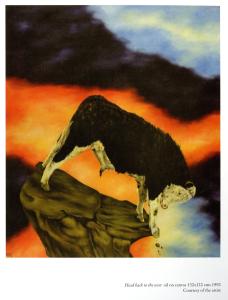
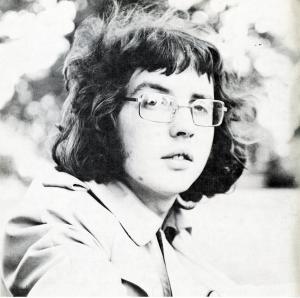
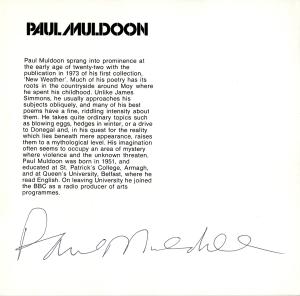
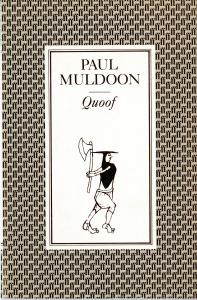
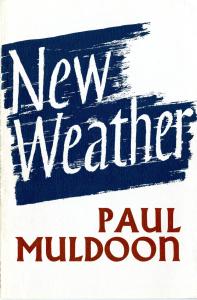
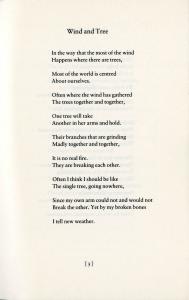
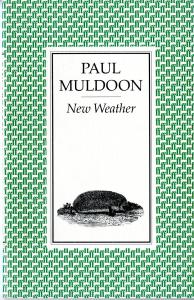
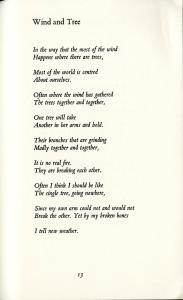
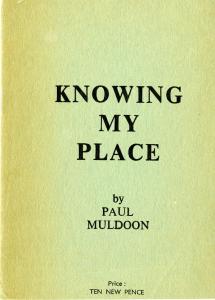
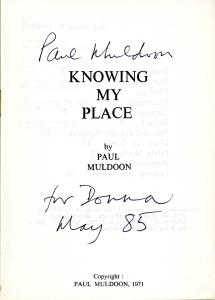

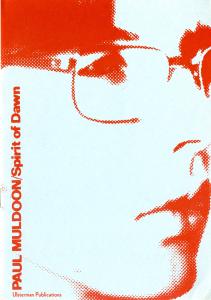
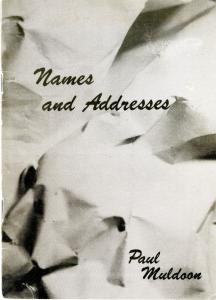
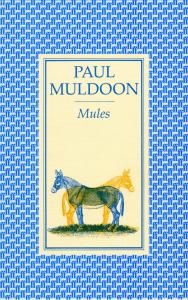
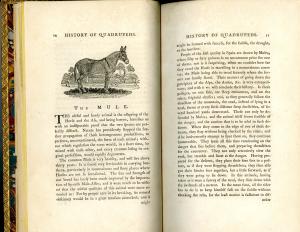
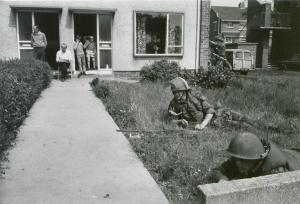
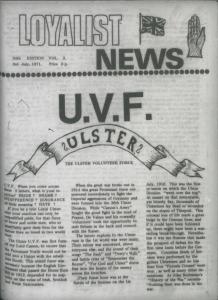
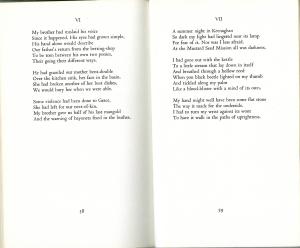





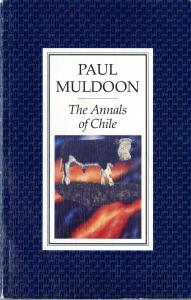
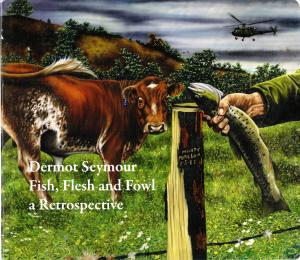
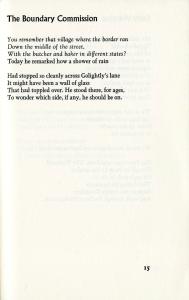
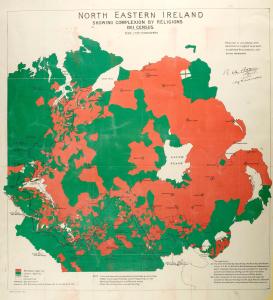
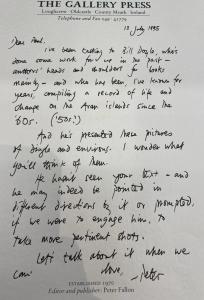
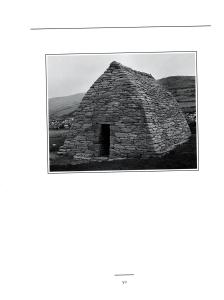
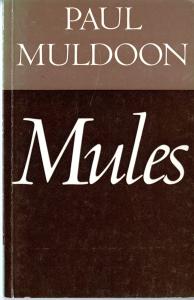
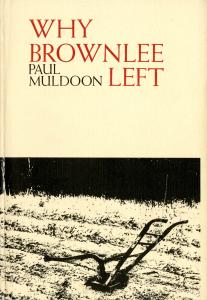
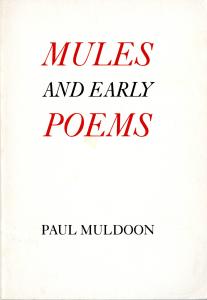
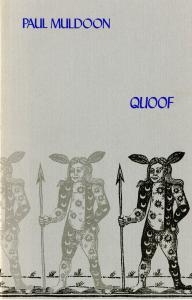
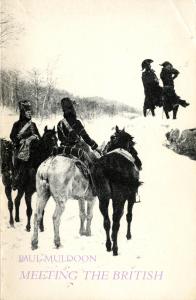
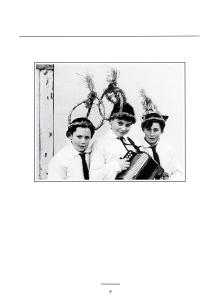
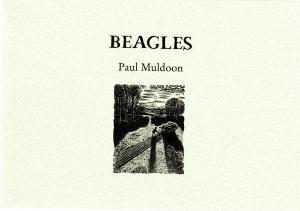
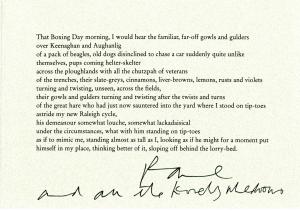
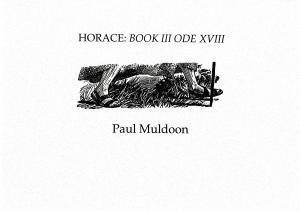
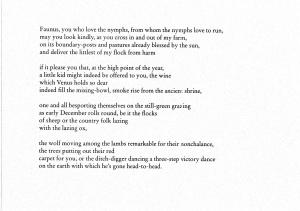
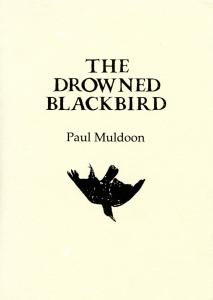
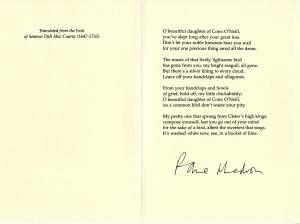

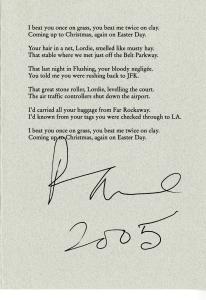


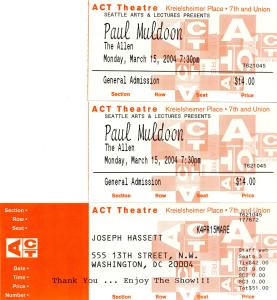
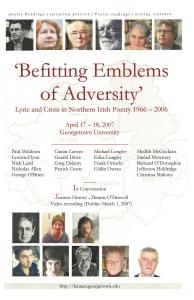
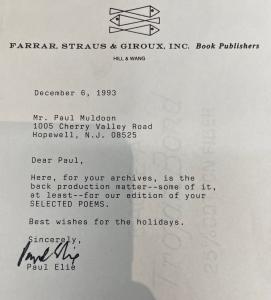
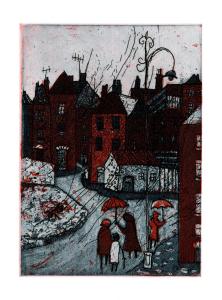
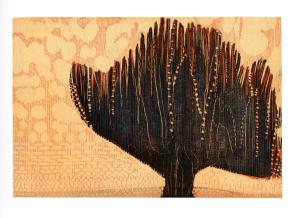

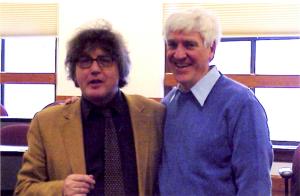
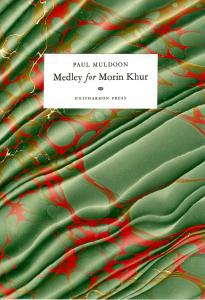
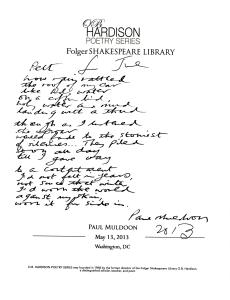
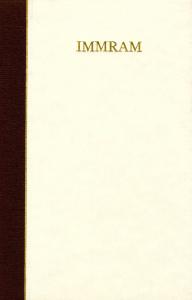
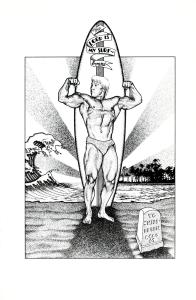


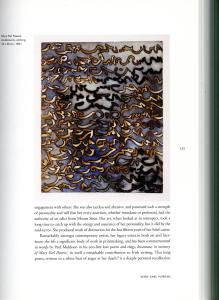
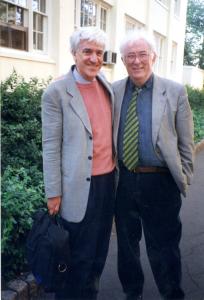
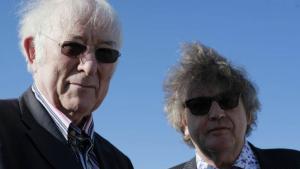
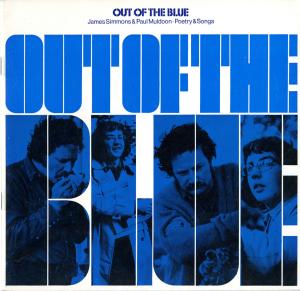
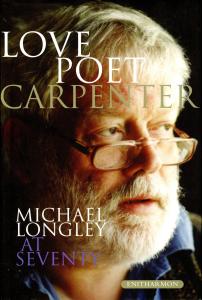
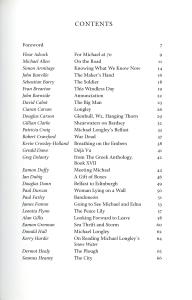
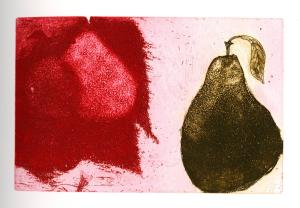
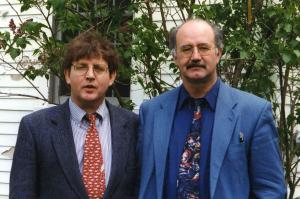

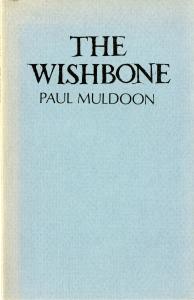
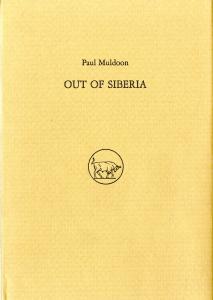
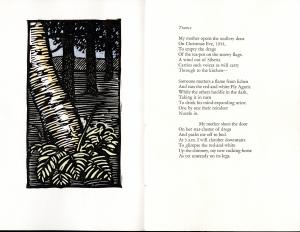
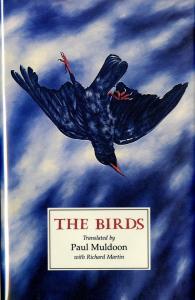
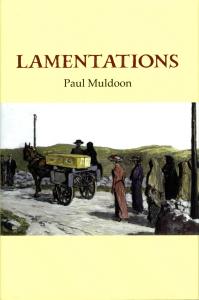
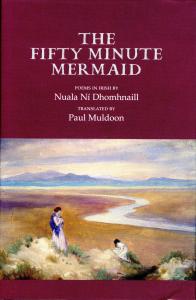
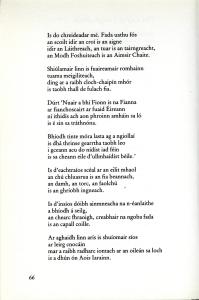
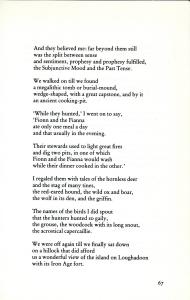

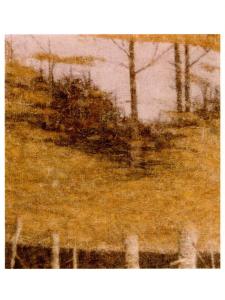

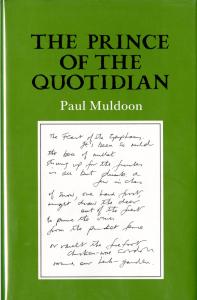
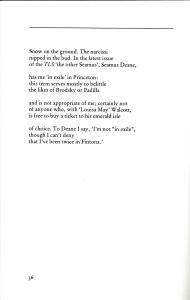
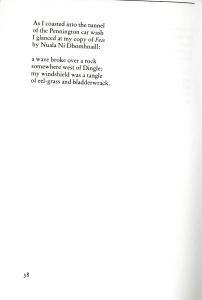
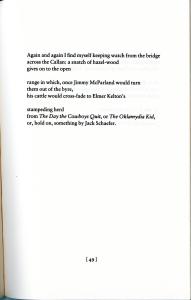
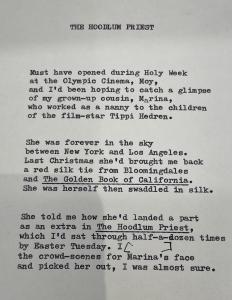
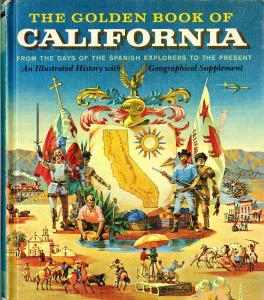
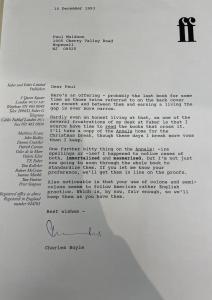
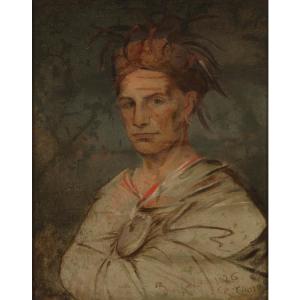


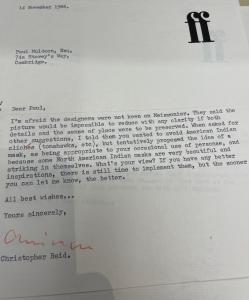
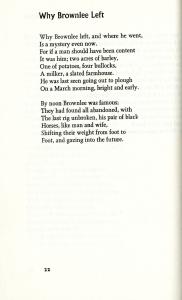
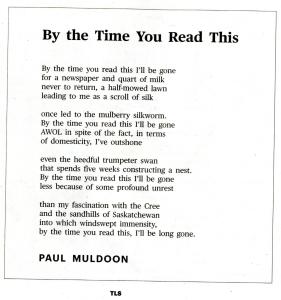
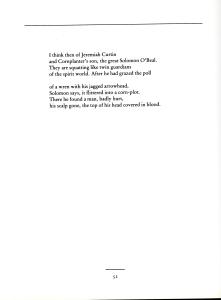
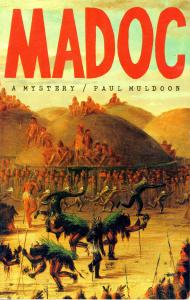
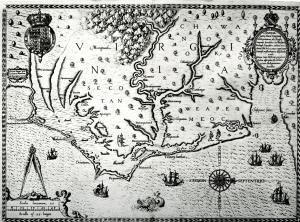
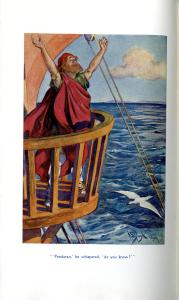
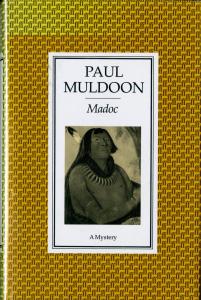
![draft of the “[Derrida]” fragment from Madoc: A Mystery](/sites/default/files/styles/exhibition_thumbnail/public/2024-04/IMG_1384.jpeg?itok=AaS_vUgr)
